Concussions and CTE What You Need to Know 6 Part Series Part 3…Get Part 1 Here
What pathological events are involved in brain injury following traumatic insult?
Following a traumatic brain injury, your body undergoes acute changes. These are mainly due to mechanical damage done by impact or inflammatory reactions triggered by the cellular damage and excitation of neurons. Depending on the duration of injury and onset of these changes, they are divided into two main classes.
- Acute or primary changes (occurring within first few minutes of concussion)
- Sub-acute or secondary changes (occurring within 24 hours of injury)
A detailed account of these two is given below:
Acute changes
The immediate set of changes is due to mechanical force impacted on the head. This force damages the vascular and neural structures in the brain. The intravascular and intracellular contents come out and cerebral flow changes. The metabolic changes are also evident in first few minutes and cause cellular damage by producing free radicals. Four important changes, all leading to brain damage eventually, are enlisted below:
- Axonal damage
The mechanical force compresses or even injures axons of your neurons, compromising the communication in the brain. That explains chemical imbalance and altered brain function. The transport deficit in axons also leads to structural abnormalities and brain damage.
- Mechanical injuries
The impact or hard blow can cause mechanical injuries. If vessels of the brain are compressed, oxygen supply breaks off, leading to hypoxia and brain damage. Depending upon the extent of damage to blood vessels, hemorrhage may develop. The force can also cause tissue death, causing swelling and edema in the brain.
Due to the onset of swelling, intracranial pressure increases and that also disturbs cerebral blood flow, leading to the shortage of oxygen and eventual brain damage.
- Neuronal excitation
Neurons also get excited following a concussion and secrete neurotransmitters. These are amino acids that put the brain into a high drive, increasing neuronal flow. One such amino acid is glutamate that can excite your brain function. It can cause tremors and contribute in the cumulative effect of concussion discussed in the above section.
Over-excitation of neurons causes an influx of calcium and inactivates free radical neutralizers. These are scavengers of free radicals that protect your brain from cellular damage. When deactivated by hyper-excited neurons, free radicals get a free ticket to damage your brain and cause brain injury.
“Over-excitation of neurons causes an influx of calcium and inactivates free radical neutralizers.”
- Damage to blood brain barrier
The mechanical and chemical changes damage the blood-brain barrier of the brain, upsetting the cerebral blood flow. Some animal studies have shown the onset of stroke due to the shortage of oxygen. This happens as a result of a combination of events including low blood pressure, structural damage to blood vessels and constriction of vessels due to different chemicals released in your body.
In short, a plethora of immediate changes transpires in your body followed by a concussion, leading to brain damage, loss of conscious, and other related symptoms.
Sub-acute changes
These are secondary changes that transpire within 24 hours and are considered long-term consequences of concussion. They are a sequel of primary changes mostly, and include:
- Oxidative damage
Following a few hours after a concussion, the primary changes lead to extensive damage and release of free radicals. These free radicals increase the oxidative burden on the brain, damaging their cellular membranes. These free radicals also react with proteins, lipids and other biomolecules that augment the production of even more radicals.
It’s a vicious cycle that continues and fills your body with metabolic byproducts that are toxic to your brain. Naturally, your body has a number of antioxidants that counter these reactive ions and prevent their damage but the primary changes deactivate many of these protective antioxidants.
Also, numerous free radicals cause a demand and supply deficit, overwhelming your antioxidant stores. In the absence of these protective molecules, secondary changes are inflicted with extensive oxidative damage in your body and particularly in the brain.
- Inflammation
Another long-term change is inflammation triggered by a concussion. It’s a compensatory mechanism initiated by your body to counter the insult.
Within few hours, your body starts producing cytokines, chemicals that trigger inflammation, that participate in tissue repair. These cytokines are numerous and each plays a respective role. Some of them are neuroprotective but some collateral damage is associated with this whole phenomenon.
Some cytokines, in an effort to repair your brain injury, alter the tone of your blood vessels and upset blood flow. They dilate the blood vessels to promote the supply of nutrition to the injury site and improve healing. However, this dilation causes cerebral edema and reduces the oxygen supply. This shortage slows down the metabolism and alters brain function.
Inflammation also triggers the suicide of cells (called apoptosis) that have already been damaged. In wake of this compensatory mechanism, many healthy brain cells also die and cause long-lasting devastating effects.
- Ischemia (inadequate blood supply)
Ischemia occurs as a result of many primary as well as secondary changes. The disturbance in blood brain barriers, compression on blood vessels and edema caused by cytokines lead to ischemic damage. It accumulates lactic acid in the brain and decreases the production of ATP. This increases the oxidative burden and vasospasms that worsen the outcome in the recovery process of concussion.
All these changes combine to inflict physiological and psychological changes in the body and that’s why concussion should not be taken for granted.
How does diet help improve recovery following traumatic insult?
To prevent damage and improve the healing process, an appropriate diet should be consumed. Many studies have measured the scope of diet and its role in the recovery process and the results are promising. These diet recommendations are based on the capability of foods to counter changes inflicted by a concussion.
“To prevent damage and improve the healing process, an appropriate diet should be consumed.”
Here is an overview of the type of foods that can help you improve the healing process after concussions. More detail about these foods will be in the sections to come.
- Antioxidants
Oxidative damage ensues early in the period followed by a concussion episode so, there’s an immediate need to counter it before it becomes too extensive.
Food materials full of antioxidants like vitamin C and E can be consumed to ease the oxidative burden. Research has shown limited scope of single antioxidant being effective in alleviating the oxidative damage. So, a combination must be used because it gives better results.
- Choline
The efficacy of choline is still under scrutiny but some prior studies have shed light on this simple nutrient being protective in brain injury. Concussion boosts the influx of calcium in primary changes and leads to cell death. Choline has shown promising results in opposing this calcium-mediated cell death.
- Branched chain amino acids
Branched-chain amino acids (BCAAs) are famous for increasing muscle mass. These are also involved in the formation of neurotransmitters in your brain and compete with many of them to pass through the blood-brain barrier. This fact has motivated scientists to check the efficacy of these amino acids in the recovery process. They are also expected to have healthy effects on cognitive functions of the brain.
- Vitamin D
Some animal model studies have shown protective effects of vitamin D in stroke. Since concussion can be rapidly followed by stroke, vitamin D is thought to be effective against this brain damage. it also binds to DNA receptors and triggers the cellular functions. These include cell differentiation, proliferation, and neuronal growth. These phenomena speed up the recovery procedure and can repair brain damage.
- Zinc
Zinc is an important nutrient required on a daily basis. Along with many significant functions performed by zinc in the body, it acts as a cofactor for many enzymes. It’s crucial for the working of enzymes found in the nervous system as well. So, for a speedy recovery, zinc supplementation is recommended.
Research shows that an excess of zinc can excite neurons. It logically follows that a deficiency could be responsible for triggering oxidative damage. So, a deficiency should be prevented when it’s already hard for your body to face the oxidative burden caused by concussion. Zinc has also shown positive effects in people with close head injuries.
- Magnesium
The role of magnesium in alleviating brain injury still needs to be studied but its ability to counter excessive neuronal excitation gives clue of its efficacy.
Magnesium is an important mineral with a neuroprotective function. It regulates the flow of calcium and opposes the action of glutamate, an excitatory neurotransmitter. This can prevent potential brain injury that is most likely to happen due to over excitation and eventual edema.
- Polyphenols
Polyphenols are organic compounds found in nature. Their health benefits are numerous and now they are considered effective in the healing process of a concussion. These are flavonoids and stilbene which participate in alleviating oxidative damage. The curcumin and resveratrol (found in turmeric and berries) are most effective among those which have a positive effect on brain injury.
- Fatty acids
Fatty acids like Omega-3, Omega-6, and fish oil have beneficial effects on inflammation. They alleviate free radical production and also maintain cell membranes. They increase thickness and fluidity of cell membranes, making them stronger in face of free radicals. That’s why these fatty acids thought to have a positive effect on recovery.
- Ketogenic diet
Brain injury impairs glucose metabolism and an alternate source of energy can do a great deal of help. Ketogenic diet comes to rescue you in this turmoil and provide you with an alternative source of energy during brain recovery. Since the energy and nutritious requirements become sufficient, the healing process becomes speedy and risk of complications goes down.
- Creatine
Creatine, like BCCAs, is also used for improving strength and muscle mass. It’s fairly common among military personnel. It is thought to influence cognitive function in brain and research has shown high efficacy in improving the recovery process after a concussion.
Creatine plays its role by protecting cerebral blood flow and maintaining mitochondrial function. Both these get messed up in acute changes and need immediate attention. Creatine gives that attention and makes healing faster, saving you from the risk of multiple concussions.
“Creatine plays its role by protecting cerebral blood flow and maintaining mitochondrial function.”
WHAT ARE THE EARLY NUTRITION NEEDS FOLLOWING A TRAUMATIC INSULT?
How does the glucose and protein homeostasis change following brain injury?
Following TBI, glucose metabolism shows significant changes. These changes are associated with a shift in energy demand and supply, enzymatic changes, and cellular damage done by a concussion.
Changes in glucose metabolism
It’s a no-brainer that your energy requirements increase after a major concussion. Your cells need nutrition for recovery as their metabolic demand increases. The problem, however, arises when there is an imbalance in energy produced and energy consumed.
Research shows that energy supply rapidly decreases following a brain injury. It can be constituted to multiple causes and metabolic changes occurring after a concussion. Whatever the underlying reason may be, this shortage is due to insufficient glycolysis. Glycolysis is a process of ATP (Adenosine Tri-Phosphate) production by metabolizing glucose. In the course of injury, this metabolic process gets affected and energy levels go down.
Glycolysis is a multi-step process and requires suitable substrates and enzymes laced with appropriate cofactors. This simple energy producing process also needs a correct balance of carbohydrates and proteins in your body.
In TBI, glucose levels decrease for many reasons, which will be discussed later. So, a substrate limitation is present. The proteins are also limited, however, and that is due to cellular damage done by a concussion. The enzymes available in cells suffer traumatic damage due to injury. They also get a supply and demand deficit because the cellular damage is repaired by these enzymes and recovery phase takes a toll on them.
This imbalance leads to an energy crisis and potential for another cascade of injury. Add to it the oxidative burden and vascular insults associated with a concussion and you get a disastrous package. Considering that glucose is the primary source of fuel for your brain, no wonder a concussion can be fatal.
A sum of all the events leading to a shortage of energy is as follows:
Decrease in cerebral blood flow
Following a concussion, a decrease in cerebral blood flow is noticed. Due to the impact of force, vascular injury often occurs and that leads to an interruption in blood supply. This hindrance leads to decreased availability of glucose to brain tissue. The metabolic needs are not met and energy crisis ensues.
“This hindrance leads to decreased availability of glucose to brain tissue.”
Research shows that immediately after a concussion, the brain has to tolerate up to 25% decrease in blood flow. This continues for a few hours before the recovery phase ensues and blood flow comes back to normal. The whole episode plays a major role in the energy crisis of brain and alterations in glucose metabolism.
Apart from this, glucose tends to decrease in blood generally and that seems like a universal response following the brain injury. The reduced glucose bioavailability can initiate secondary injury response and more cellular damage. Plasma levels of glucose are difficult to monitor in a patient with a concussion because the management includes careful maintenance of glucose levels therapeutically.
Defective glucose transport
Another reason for low glucose levels in patients who have suffered a blow is impaired glucose transport. Glucose in your cells is transported by special transporters. These are like small trolleys which take glucose from your blood and carry them into your cells. This trolley has a fancy name and that is GLUT-4.
In brain injury, this trolley suffers an accident and its function is impaired. There’s no carriage available and your cells are unable to take up glucose. The unavailability of glucose leads to a shortage of energy and contribute to the post brain injury energy crises.
The pattern of uptake of glucose is a bit patchy and research shows that brain cells take it up in variable amounts. It also depends on the severity of the injury. The mild, moderate or severe intensity of injury has a respective effect on brain cells and their ability to take up glucose.
Some studies have shown an acute increase in glucose metabolism following a concussion. However, this occurs for a brief period and the reason is thought to be the maintenance of neuronal potential and an innate need for cells to uphold an ionic balance. When this brief episode passes and the injury makes it mark, the depression emerges. The decrease in glycolytic activity is prolonged and may continue for 10 to 15 days, until the complete recovery. This hyper-glycolytic phase is associated with glucose uptake and cellular ability to pump it in the brain.
Problems within cellular machinery
The concussion also affects the metabolic machinery of cells and alters glycolysis. When an injury occurs, your body initiates many compensatory mechanisms to cope up with that insult. All those processes, in one way or another, are designed to repair the damage and restore brain function which temporarily gets halted by a concussion. Glucose or the enzymatic machinery involved in its metabolism also plays a major role in these compensatory mechanisms and resultantly, glycolysis is affected.
A significant amount of glucose is shifted to another process called the pentose phosphate pathway. This pathway is responsible for the formation of nucleic acids that are responsible for repairing damaged cells. This shift of glucose leads to substrate limitations.
Another constituent of glycolysis lowers due to DNA repair and that is NAD (Nicotinamide dinucleotide). NAD is a cofactor required for activation of enzymes involved in glycolysis. The deficiency leads to insufficient levels of glycolysis and resultantly fewer ATPs, contributing to the energy crisis.
Shift to anaerobic respiration
The normal physiological response of the body to injury is an increase in metabolism. Considering damage to the cells and repair process required to restore normal body function, it’s understandable. However, a substrate limitation occurs as described in detail earlier, leading to energy deficit. To compensate this energy deficit and substrate limitation, a shift of metabolism to an anaerobic side occurs.
In normal circumstances, the product of glycolysis is pyruvate and this pyruvate enters into another cycle to produce energy from glucose. As discussed, following TBI, the enzymes required for entering pyruvate into another cycle are not sufficient. So, pyruvate is rapidly converted into lactate (lactic acid). The ratio of pyruvate to lactate increases and an anaerobic respiratory process continues in the body.
Mitochondrial dysfunction also contributes to this anaerobic respiration and inflammation is triggered in response. All these metabolic changes combine to produce an environment in your body that exacerbates the injury and contribute to its harmful impacts. Research shows that an accumulation of lactate also makes your brain prone to the second layer of injury.
Summarizing the glucose metabolism:
Protein homeostasis
Concussion brings about two types of changes in proteins metabolism: immediate and long-term.
Immediate changes include secretion of neurotransmitters in the brain. Among all of these amino acids, glutamate is the most abundant one. This secretion occurs due to mechanical impact or the excitation of neurons in the brain. These neurotransmitters bring into play the immediate changes inflicted by a concussion. They also alter brain functionality and coordination.
Late changes point out a connection of concussion with neurodegenerative diseases. Traumatic brain injury has a potential to cause degenerative problems in brains, similar to those caused by diseases like Parkinson’s and Alzheimer’s. These changes include accumulation of certain proteins between brain cells. The tau protein is one of many proteins that tangle up and settle between brain cells. These proteins have extensive harmful impacts and are associated with multiple brain injuries. Research shows that individuals who suffer from multiple concussion injuries have more chances to have these tangled proteins.
Apart from these, normal protein balance of body gets disturbed and edema ensues. That’s why in initial phases of brain injury, the diet needs to be abundant in proteins. Proteins are generally required for repair process as well. Due to injury, the cellular membranes get damaged and calcium overload occurs. An excessive influx of calcium activates many transport proteins in the cells and excites many pathways leading to altered communications. The structural integrity of cells becomes compromised and inflammation is exacerbated.
“That’s why in initial phases of brain injury, the diet needs to be abundant in proteins.”
An imbalance in protein homeostasis also leads to oxidative burden in the body. An immense amount of free radicals unleash in your brain and contribute to the damage done by a concussion.
How do the energy requirements change soon after a brain injury?
The energy demand increases following a concussion and the mechanism has been discussed in detail in the previous section. One last verdict that needs to be mentioned here, however, is the energy recession.
Due to damage, a general decrease in cellular constituents and most importantly, a functional deficiency of mitochondria, the energy production decreases significantly. Glycolysis occurs insufficiently so the production of ATPs drains and cells have to rely on other (anaerobic) means to produce energy. This shift has its own side effects and plays a major role in exacerbating the injury. To check these energy setbacks, a high-energy nourishment is recommended soon after brain injury.
Part 4 dives deeper into the specific nutrients that can speed recovery after a concussion has occurred!
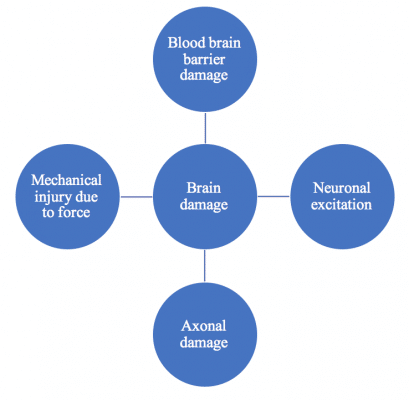
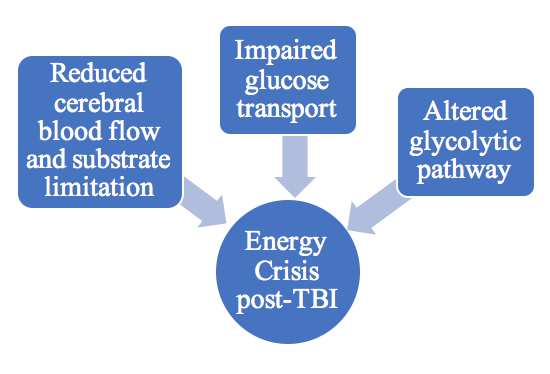
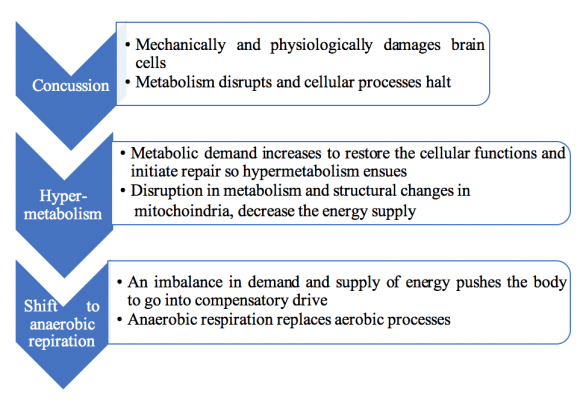



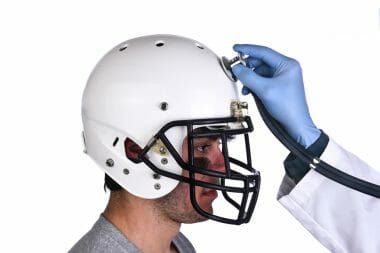
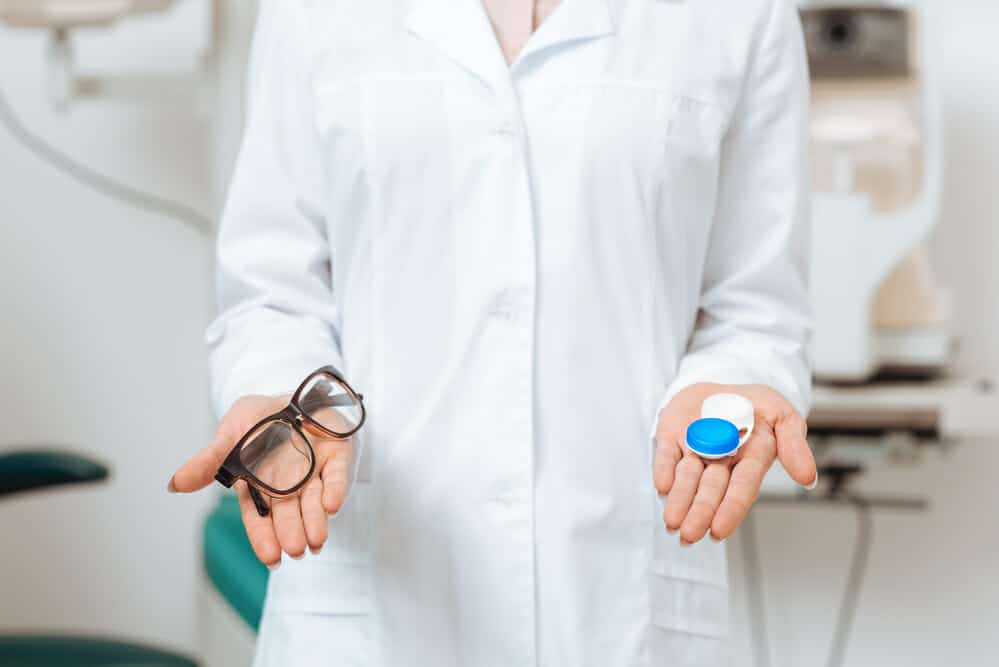



Reply